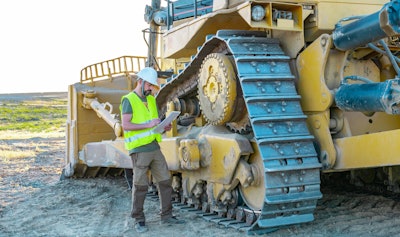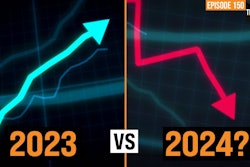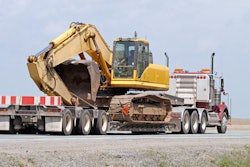
The first half of 2024 should bring stronger growth in construction, according to Richard Branch, Dodge Construction Network chief economist.
He remains confident that the U.S. economy will remain recession-free this year, despite some of the ongoing and new challenges it faces.
After a year in which the economy and starts slowed considerably, Branch projects a transition to stronger growth for construction.
Releasing the Dodge Construction Network 2024 outlook, he believes there is growing evidence that Federal Reserve Chairman Jerome Powell is done with the ongoing interest rate increases, based on recent employment and data that suggests inflation is dropping.
“I'm never going to say we're mission accomplished here, but I think Chairman Powell is feeling pretty good about what the situation is,” Branch said.
Per the Dodge Construction Network 2024 outlook, total construction starts are expected to gain 7% to $1.2 trillion, after growth slowed to just 1% in 2023 and was down 2% when adjusted for inflation.
“The way we're looking at the construction sector is that we're anticipating that 2024 will bring about more consistent growth, as well as more opportunity in the construction sector, but that the economy will remain challenged at least over the next three to six months,” Branch said. “We think by the end of the year, the US economy is going to be on much more stable footing where there should be more opportunity in the construction market.”
While the odds favor growth, the Dodge Construction Network’s 2024 economic outlook still highlighted some concerns in the first half of the year.
These include possible new union strikes, higher energy prices created by the conflict between Israel and Hamas, and the question of what impact Congress could have on construction spending.
While Congress averted a government shutdown with approval of a continuing resolution, Branch said that action could still hurt construction.
“If you think about what's going on in terms of appropriation bills, we're now in a new fiscal year that started on October 1, and those appropriation bills impact, how the annual increases come into the infrastructure funding,” he said.
From a labor perspective, there remains a possibility of more major strikes on the heels of the UAW strike that strongly impacted Q3 and Q4.
“There's been a lot of rumblings that that there could be further labor action,” Branch said, noting that for his projections, the assumption is any additional labor actions will not rise to the level of impacting the economy.
Across the world, the geopolitical risk remains intense with Russia, Ukraine, Israel and Hamas. For his forecast, Branch said he is assuming an ease in tensions over the next six months.
“The worry would be if there is another run up on oil prices, it could negatively impact the U.S. economy,” he said.
Materials prices have dominated most conversations within the construction industry. Data is finally contracting on prices of building materials compared to the steep run-up that was seen in the wake of the pandemic.
Branch said bid prices are essentially flat from where they were last year. Based on his analysis, he projects that there should be some relief in bid prices over the coming months in Q1 and even into early Q2.
"I don't think we're going to see a steep run-up in bid prices or material prices like we saw back in 2020," he said. "Nor do I think we're going to see any sort of protracted decline. I think the best that we can hope for by the midpoint of this year is for both bid and material prices that are returning to more what we call normal growth or somewhere in the 3 to 5% range year over year."
Residential
Branch projects gains in residential construction in 2024 after a challenging year in 2023 which saw single-family starts fall 12% due to rising mortgage rates. Branch noted that the multifamily market dropped 13% due to overall stress on the financial market.
The Dodge economist projects a more upbeat outlook for 2024, provided the Federal Reserve as minimum halts the increases and more significantly begins lowering the interest rates as inflation subsides.
For the first half of the year, he said rates are expected to remain stable at slightly above 7 percent. However, Branch suggests that once the Fed begins to ease the rates in the latter half of the year, that will lead to an increase in single-family starts.
According to the Dodge forecast, single-family construction will increase by 9% to $244 billion in 2024 as the number of units improves by 3% to 845,000.
Branch anticipates that the overall economic improvements will play a role in stabilizing the financial markets and likely prompt developers to reengage with plans for multifamily units as well, leading to a projected 14% gain to $161 billion and 3% growth in units to 740,000.
“If we want to talk about our feelings and how we feel about a forecast, a decline is a decline and your business plans need to reflect that,” Branch said. However, he noted that reviewing the levels of activity in multifamily construction from 2021 through 2024 it is the highest levels for the sector since the 1980s.
Commercial
The Dodge Construction Network projects commercial construction will continue to see a modest decline during 2024 as starts drop 2% to $153 billion and square footage slides a more substantial 10% to 843 million square feet.
A more mixed outlook, however, is evident within the different commercial construction sectors. In dollar value, warehouses, offices, and parking garages will decline, while retail stores and hotels will begin to grow.
Branch noted that commercial construction has borne the brunt of the Federal Reserve’s tighter monetary policies, but structural changes occurring within several commercial markets have magnified the problem.
He noted for example that significant increases in working from home have negatively affected office construction, and Amazon’s moratorium on new warehouse construction has negatively impacted warehouses.
Other sectors
Over the past couple of years, both the CHIPS Act and the Inflation Reduction Act have provided funding to bolster investment in domestic manufacturing. Continued growth in that sector is anticipated in 2024.
However, Branch added a caveat on that projection based on the limitation of the growth that occurred in 2023 due to labor shortages which delayed several projects. It remains to be seen if those delayed projects will advance in 2024 and what new ones will get underway.
In addition, Branch said institutional starts will inch forward but barely keep up with inflation.
Infrastructure
In 2024, public works will continue to benefit from several federal legislative initiatives passed to help improve the nation’s aging infrastructure.
The Dodge Construction outlook shows a modest 7% increase for nonbuilding/infrastructure construction, with the caveat of the potential negative is the chaos surrounding appropriation bills, which could delay spending increases for infrastructure that could push start dates even further out.














